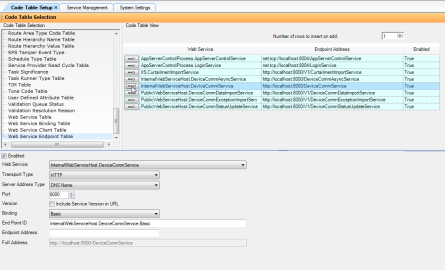Configuring Web Service endpoints
-
In IEE, select System Administration > System Admin > Code TableSetup.
-
From the Code Table Selection list, select Web Service EndpointTable.
-
In the table, select the web service with DeviceCommService as the Endpoint Address. If there is not a web service with DeviceCommService as the Endpoint Address, add it.
-
Click Enabled to enable the client.
-
From the WebService list, select InternalWebServiceHost.DeviceCommService.
If you do not see this web service in the list, add it to the Web Service Table. For more information, see Configuring DeviceComm Web Services.
-
From the Transport Type list, select HTTP.
-
From the Server Address Type list, select the server address type. The default is DNS Name.
By default, the port number is set to 8000. Unless you need to use a different port number, leave it as is.
-
(Optional)To include a service version indicator, click Include Service Version inURL.
-
From the Binding list, select Basic unless you need to configure security.
-
In the End Point ID field, enter the ID for the endpoint.
Typically, you should follow the convention of
<Web Service ID>.<Binding ID>. This should be unique within all web service endpoints. -
If needed, in the Endpoint Address field enter the address of the endpoint. This address is appended to the address listed in the Full Address field.
The read-only Full Address is the URL for this service endpoint. This follows a format of
<TransportType>//<localhost>:<port>/<Web Service.ServiceClass name>/<Endpoint address> -
Click Save.

Configure each of the following services in the Web Service table and the Web Service Endpoint table.
-
DeviceCommAsyncService
-
DeviceCommDataImportService
-
DeviceCommExceptionImportService
-
DeviceCommStatusUpdateService
For more information on specific values, refer to the IEE MDM Installation, Configuration, and Upgrade Help.